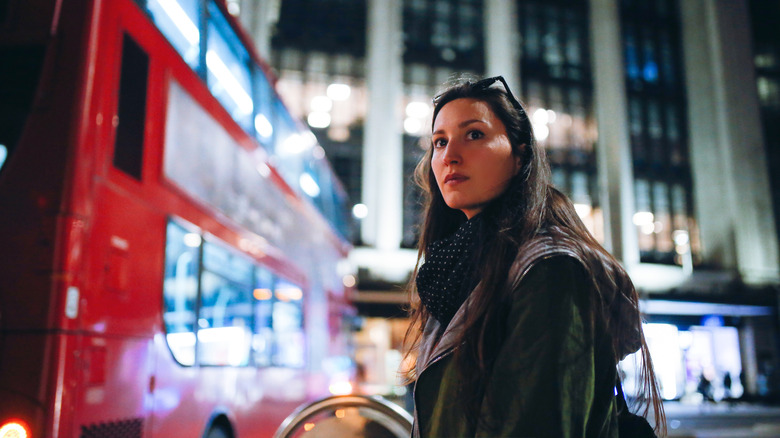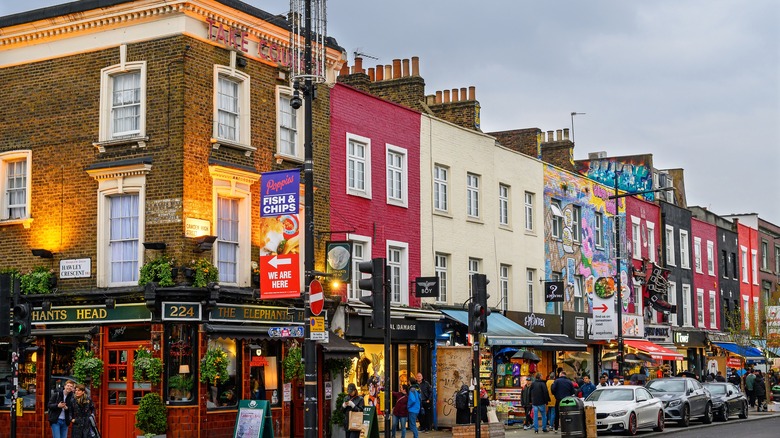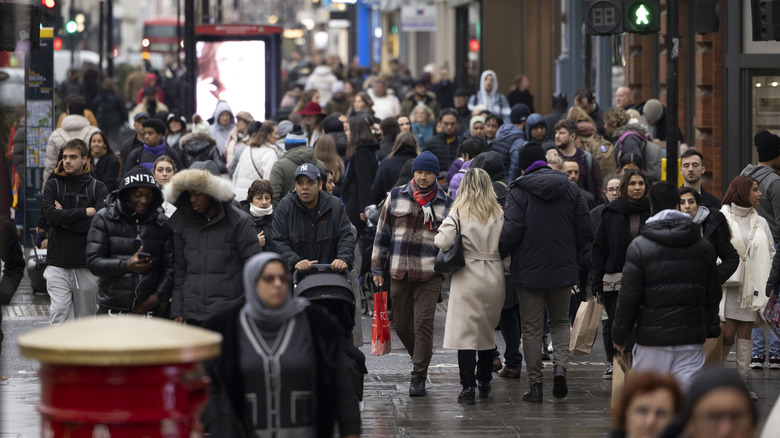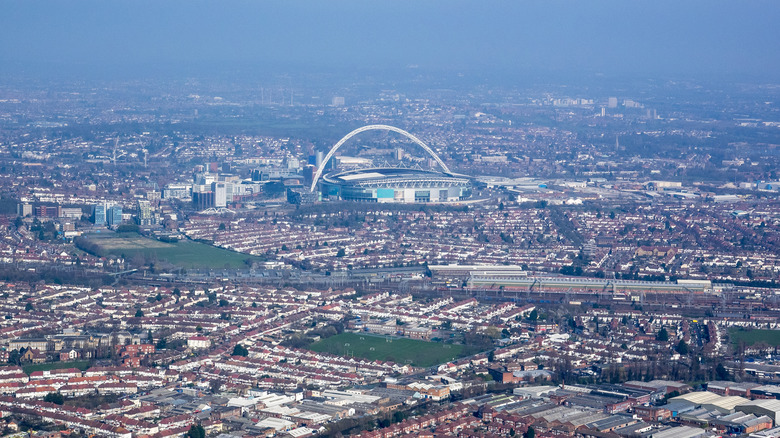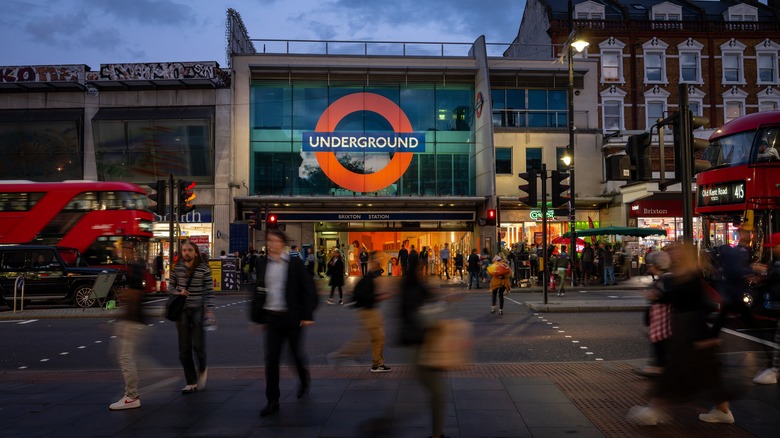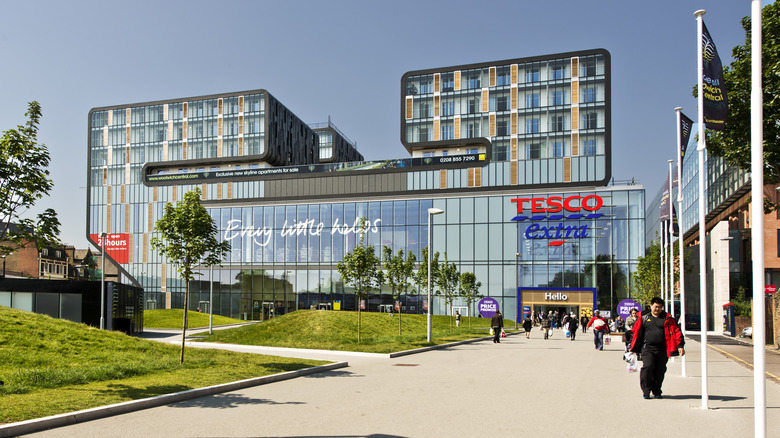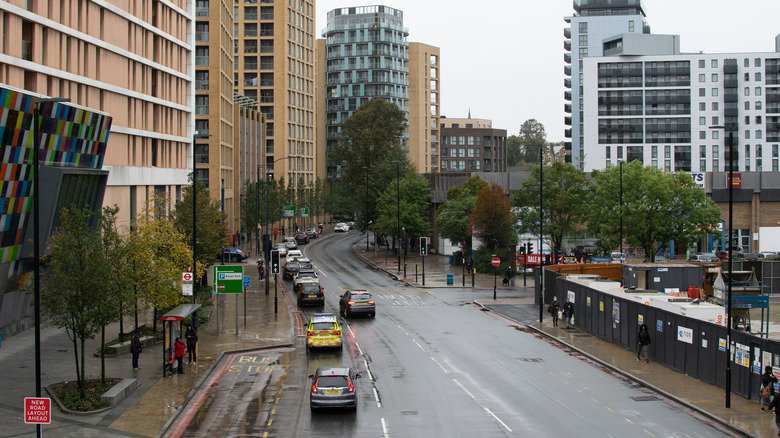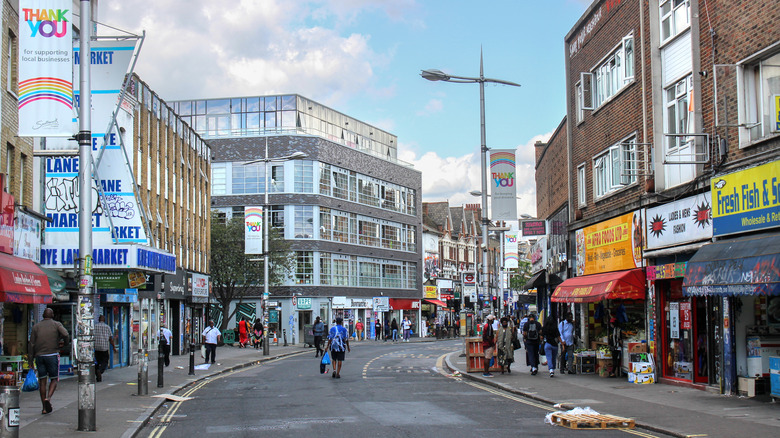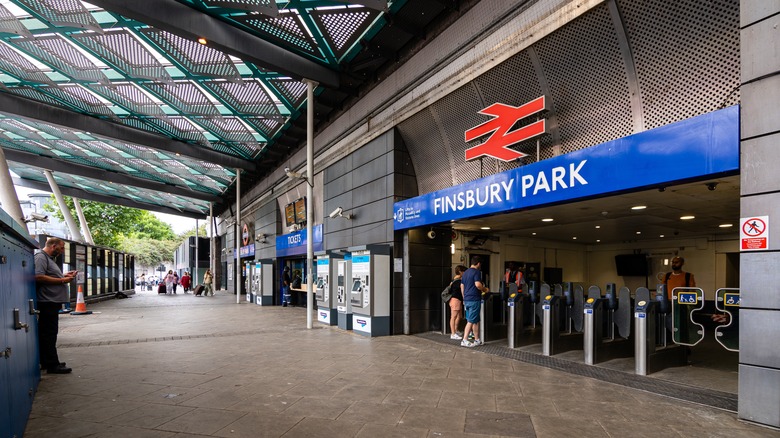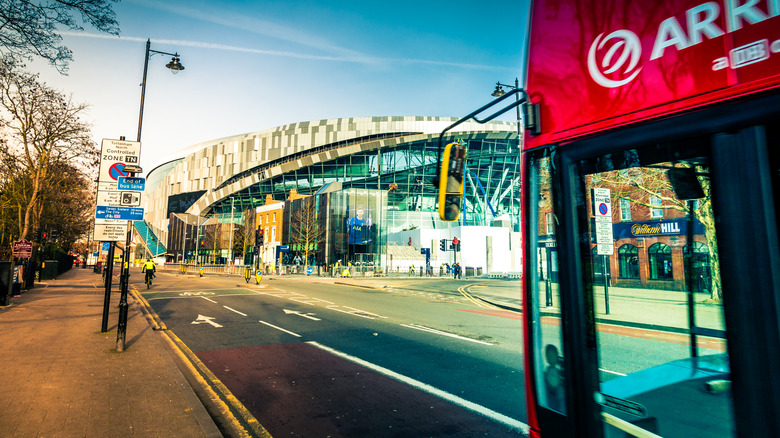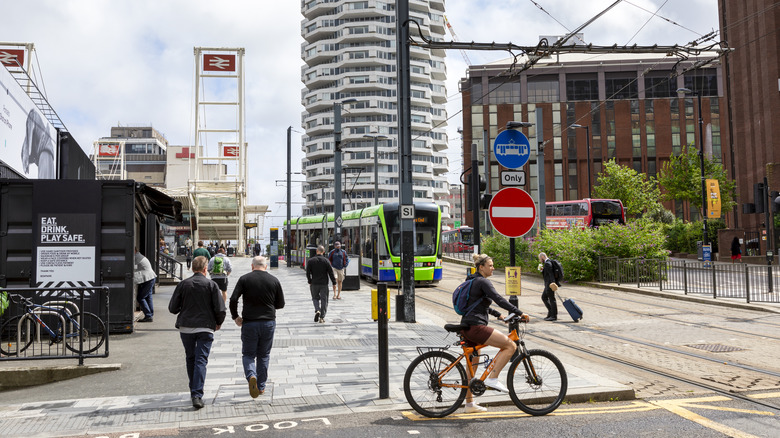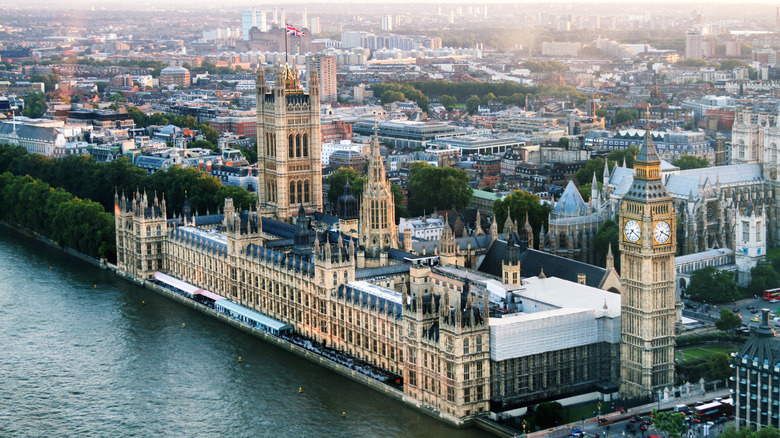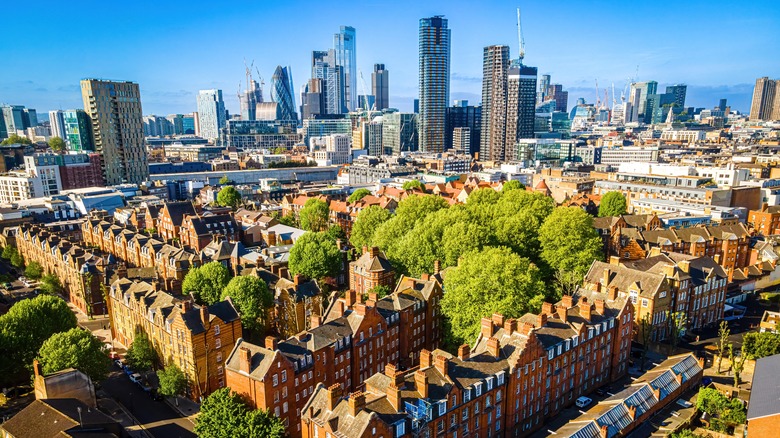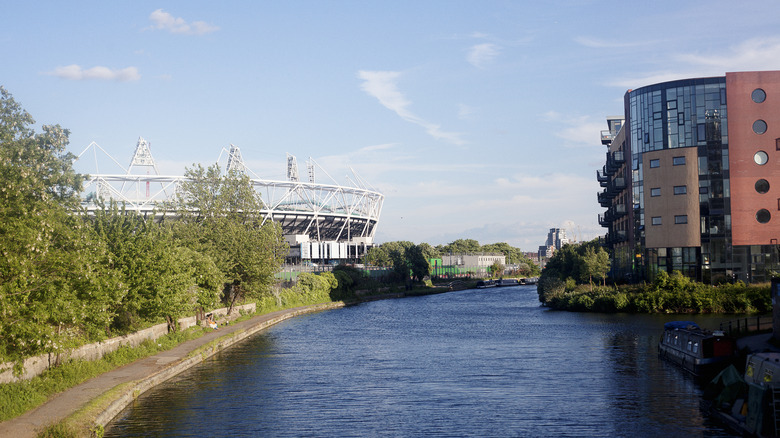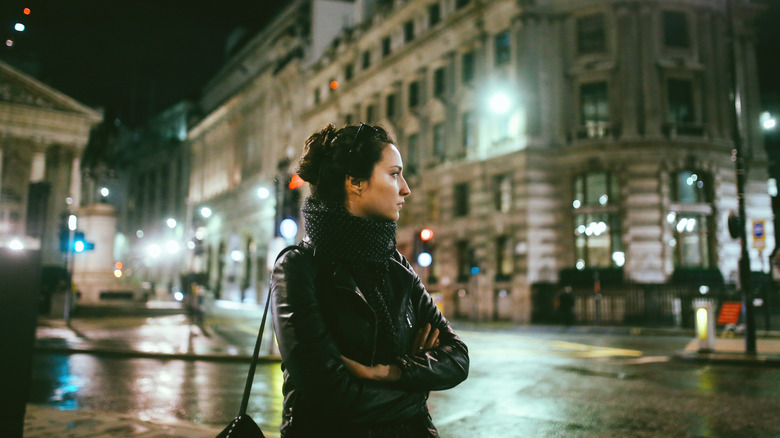Dangerous Destinations In London You Should Really Skip On Your Trip
Food, culture, history, entertainment — London truly has it all. Travelers flock from all over to visit this ancient English city, making it one of the most popular destinations in the entire world. But between unmissable attractions like Big Ben, Buckingham Palace, Tower Bridge, and its thousands of restaurants and pubs, London is home to many of the same dangers as any other big city.
Any Londoner who's called the capital home for more than a few months will be able to guide you on the dos and don'ts of staying safe during your visit. If you aren't lucky enough to navigate with a local at your side, we've put together a guide of the areas you may want to avoid with the aid of our own lived experience in the city and some trusty crime stats. Of course, that doesn't make these spots total no-gos. Realistically, you could run into danger anywhere — and you should always remember that touristy areas tend to be hotspots for crimes like petty theft, purely because thieves see out-of-towners as easy targets. Stay vigilant, and you'll make the most of your time in The Big Smoke.
Camden
With its colorful stands, alluring scents, and bustling atmosphere, Camden Market is catnip to tourists. Among Londoners, it has a less savory reputation. The borough's theft, violent crime, and vehicle offense rates are notably higher than most other areas in the city, technically making it London's second-most dangerous borough, according to CrimeRate.
The area is always busy in the daytime, so you're unlikely to run into any major trouble. However, in the past few years, Camden has become a real hotspot for phone snatching and bike or moped robberies, especially in the crowds that tend to gather around Camden Town Station. We recommend keeping your phone out of sight, preferably zipped up in your bag, and staying alert to who's around you.
While Camden is an excellent place for a night out, it can also feel a lot more unsavory when the sun goes down — particularly for women. Local female councilors have raised the issue and have promoted the "Ask for Angela" scheme throughout the area. If a woman feels unsafe in any way in Camden, they can enter nearby bars, pubs, or clubs and ask to speak to Angela. The word acts as a sign for staff to provide support, help you get a taxi, or contact police on your behalf.
Oxford Street
Not so long ago, Oxford Street was the pinnacle of high street shopping — home to flagship stores such as Selfridges, Primark, and the Disney Store. Since the COVID-19 pandemic, however, it's gradually become a shell of its former self. While it's still the busiest shopping street in Europe, an ever-growing number of retail spaces sit abandoned with the likes of Topshop, Debenhams, Miss Selfridge, Adidas, and more packing up shop.
As brands have left the area, it's become increasingly more dangerous. Pickpocketing rates are high on Oxford Street, as are vehicular accidents and lootings. In August 2023, a disturbing TikTok trend saw crowds gather to loot the sports fashion retailer JD Sport. Long before this, a travel advisory was even issued to residents of the United Arab Emirates visiting London, warning them to avoid Oxford Street in general.
Fortunately, you aren't missing out on much if you don't go. Other areas — such as Carnaby Street, Regent Street, or even London's two Westfield malls — provide a much better shopping experience, both in terms of options and atmosphere. Unless you're desperate to shell out £20 on chocolate in one of its many overpriced American candy stores, you're best leaving Oxford Street off your itinerary.
Brent
Brent isn't a particularly touristy area and has actually become much safer since the noughties when its gang activity was at a high. Statistically speaking, however, it's still one of London's most dangerous boroughs. In 2022, its overall crime rate was 90 crimes per 1,000 people, and it had high rates of gun and knife crime compared to other parts of London.
A lot of Brent is residential, so you're unlikely to pass through the borough's most dangerous neighborhoods — including Stonebridge and Harlesden — on a vacation. The one area you may find yourself visiting is Wembley, home to the world-famous Wembley Stadium (and the smaller neighboring Wembley Arena). Millions of visitors pass through the area every year, and crowds can get dense after football matches, concerts, and other events, making it a hotspot for opportunistic crime. As always, keep your belongings close to your person, and avoid carrying your phone around in your back pocket. (That rule goes for anywhere in general. Don't make life easier for pickpockets).
Brixton
Taylor Swift may sing about enjoying nights in Brixton in "London Boy," but we have our doubts about how much time the songstress has actually spent in the area. While Brixton definitely has a buzzing nightlife scene — and it's far safer today than it was even five years ago — it doesn't have the best reputation come sundown.
Although gang activity has been on the decline in the past decade, there's still been a concerningly high number of drive-by shootings and stabbings in recent years. It also has a notorious history of drug-related crimes. In 2021, a local resident described Brixton to local news outlet My London as a place where "it's literally a big thing to make eye contact with someone, an argument could start from a small thing like that." As with most parts of London, the area around Brixton tube station tends to be one of the dodgiest spots, so it's best to keep your wits about you, especially when traveling at night.
Woolwich
The borough of Greenwich has surprisingly high crime rates, considering its peaceful, idyllic, and fittingly green reputation. Most of these stats stem from Woolwich, especially the Woolwich Dockyard, Arsenal, and Charlton Riverside areas. In October 2023 alone, Woolwich Arsenal experienced 77 violent and sexual offenses. Knife crime is a particularly big concern. Since 2020, there have been nearly 1,200 incidents in the borough, and approximately one person is killed every eight weeks.
Again, like many areas on this list, you're advised to be extra careful around the train station. Woolwich Arsenal is situated at the very end of the DLR line — the ugly stepsister of London's tube lines — and the station can feel quite dark and unfriendly come nighttime. You're unlikely to find yourself spending much time in Woolwich as a tourist, or find yourself caught up in any gang activity, but we still recommend keeping to well-lit areas as much as possible if you do.
Lewisham
Back in 2013, Lewisham had the unfortunate honor of being named the least peaceful area in the entire United Kingdom. Whether that unwanted title holds up today is up for debate, but it certainly still has a not-so-peaceful reputation.
The borough is packed with students because it's home to Goldsmiths College, University of London. This means that the main streets are almost always buzzing, which can be a comfort. However, New Cross — the area where Goldsmiths is located — does have some of its highest crime rates at 181 per 1,000 people. Lewisham Central and Park fares even worse statistically at 194 per 1,000. The biggest concerns are knife crime and violence. Unless you're a student, your odds of passing through the borough are pretty low. If you do, however, just be sure to have your wits about you and try to avoid any unlit streets at nighttime.
Peckham
Peckham has undergone some radical changes in the past decade. Gentrification has hit the area hard, with many trendy bars, breweries, and cafes creeping into its high streets. This has made it increasingly popular with London's younger residents, who file into hotspots like Frank's Cafe and Peckham Arches every weekend.
Regardless, Peckham still has something of a negative rep. In 2021, it came out on top in a survey of areas Londoners try to avoid, and its borough, Southwark, has a crime rate 14% higher than the London average. Gang violence is nowhere near as rampant as the most stereotypical depictions of Peckham on TV would have you believe, but it's still something of concerning note. It's thought that at least three organized groups — Queens Road NM/23, PR15/NBR, and Zone 2 — operate in the area. Moped gangs, in particular, have surged in numbers, which makes it all the more important to keep a close eye (and hand) on your belongings while out and about. We also recommend walking on the inside of the sidewalk to limit your accessibility to any potential thieves passing by.
Finsbury Park
At first glance, Finsbury Park is much like any other popular green space in London. Actual London residents feel differently, however. In 2021, Hackney and Islington residents named Finsbury Park as the area where they felt most unsafe. A real sign of how unsettling people find the park itself — which is delightfully scenic in places — is that in 2022, residents banded together to push for local authorities to introduce measures that would once again make the park "safe to enjoy or travel through, particularly at dusk, dawn and when dark."
While the park gets the worst rep in the area, visitors should also be careful around Finsbury Park Station. In fact, it's one of the tube stations that sees the most theft in all of London, which isn't exactly a landmark anybody puts on their travel itinerary. Metropolitan Police have upped the ante around the station in recent years, sending out more officers to help keep the area safe. However, it's still a good idea to double-check that your bag is zipped up and in sight at all times if you are passing by.
Tottenham
Thousands descend upon Tottenham Hotspur Stadium yearly (including pop royalty in the form of Beyoncé in the summer of 2023). Locals believe this number would be higher if it were not for Tottenham's violent reputation. Residents have described a decline in business as people are unwilling to visit the area, with one disappointed business owner telling MyLondon in November 2023 that they've "had customers say they are scared to come because of the trouble on the streets."
Said trouble tends to consist of violence and drug crime. The Mayor of London, Sadiq Khan, and the Metropolitan Police have taken action to tackle youth crime in Tottenham, but the area still saw a spate of stabbings in 2023. Residents on r/London have advised others to take extra care in the area after football matches when things can get "rowdy." Considering how chaotic this will also make the tube station, it may be best to steer clear on the days Tottenham Hotspur plays at home — unless that's your entire reason for visiting, in which case, stay careful in large crowds.
Croydon
The South London borough is out of the way — especially for tourists — but those who do find themselves dropping by the area's Boxpark or Museum of Croydon should probably note that it has been dubbed one of the most dangerous places not just in London, but the entire country. Its main shopping area, Fairfield, has the highest crime rates, with theft proving to be an issue.
Croydon's biggest issue is, yet again, youth crime. Children as young as 13 have been stabbed in the area. The issue is so bad that a knife arch was installed in a local McDonald's to crack down on violence in 2023, a year that happened to see Croydon's highest number of stabbings since 2018. There are plenty of reasons why violence has spiraled in the area, but a considerable part of it comes down to the fact that Croydon has had to declare bankruptcy three times in recent years — massively destabilizing the local services that exist to get to grips with these issues.
There's much more to an area than its statistics, and Croydon residents have reassured others on r/Croydon that most conflicts tend to happen between gangs or youths. However, there's also a general consensus that East Croydon tends to be safer than West Croydon.
Westminster
Picture a postcard of London, and the image is most likely Westminster. Home to the Houses of Parliament, Westminster Abbey, Buckingham Palace, and Big Ben, Westminster is mainly populated with tourists (and politicians). For that reason, it's also seen as easy pickings for pickpockets; two offenses are thought to occur on the streets of Westminster every hour. House break-ins are also concerningly growing in frequency, and the area is home to London's highest rate of Islamophobic crimes.
Thanks to these stats, Westminster technically also has the highest crime rate in all of London. While it's an unmissable area for any visitor hoping to check off the biggest sights in the city, the usual safety precautions are vital here. It's also important to note that thanks to its political importance, Westminster also attracts its fair share of protests — particularly in Parliament Square. The majority of these are peaceful, and almost all of them are announced in advance, but action has turned violent in the past, with participants launching fireworks into crowds and clashing with police.
Hackney
Some of London's best nights out start (or end) in Hackney. Hoxton and Shoreditch are extremely popular areas for lively nightlife and, by day, are also equally popular for their shopping and foodie scenes. However, they're also two of the most dangerous areas in Hackney, with even police officers complaining that they don't feel safe in Shoreditch come nightfall thanks to a rise in alcohol-fuelled violence.
For women in particular, the nightlife poses another risk: drink-spiking. While it's rare, female patrons of local bars, clubs, and restaurants have reported numerous serious incidents. You shouldn't leave your drink unaccompanied anywhere in London, but it's worth being extra careful. There are also plenty of nifty gadgets that can help you identify a spiked drink, such as testing strips and wristbands. Theft is also common, with Shoreditch proving to be another popular spot for phone swiping both out on the streets and in clubs.
Newham
Back in 2012, Newham was very briefly the most-watched location in the world. As the United Kingdom hosted the 2012 Olympics, it became the home of the Olympic Village and ushered in a new era of luxury apartment blocks – not to mention the construction of the mega-mall that is Westfield Stratford City.
But over a decade later, the shine of 2012 has worn off and left Newham struggling in the long run. House prices have surged, and so have crime rates. Newham holds the grim title of the London borough with the most murders. In fact, Newham was hit by over 190,000 crimes in 2022. A lot of youths tend to gather in and around Westfield, Stratford Shopping Centre (which sits adjacent to Westfield), and Stratford Station, and it can get hectic in the evenings and on weekends. Visitors have highlighted gang activity, looting, and knife crime, as well as theft in the parking lots, as some of the biggest risks. Be extra careful at night or when traveling alone.
How did we choose places on this list?
To break down the most dangerous spots in London, we drew on our own personal experiences of living in the city and combined them with the cold, hard statistics. Crime stats available through the Metropolitan Police are some of the biggest indicators of whether an area is safe or not, as are public posts on websites such as Reddit and Tripadvisor from those who have either visited or live in the area.
Of course, this isn't an exhaustive list — and the definition of a 'dangerous' area isn't always black and white. The reality is that London is a big, bustling city, home to millions of people and attracting millions more visitors each year. Some people live in areas viewed as dangerous for their entire lifetime and face no trouble. Others may visit once and stumble into bad luck. The places on this list are those with more recorded details of theft, violence, antisocial behavior, and other crimes.
